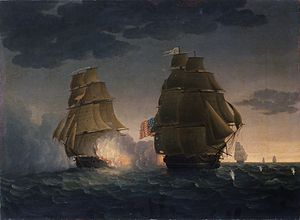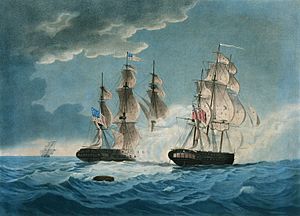Capture of USS President facts for kids
Quick facts for kids Capture of USS President |
|||||||
|---|---|---|---|---|---|---|---|
| Part of the War of 1812 | |||||||
 The USS "President" Engaging the British Squadron, 1815 by Fitz Henry Lane |
|||||||
|
|||||||
| Belligerents | |||||||
| Commanders and leaders | |||||||
| Strength | |||||||
| 4 frigates | 1 frigate | ||||||
| Casualties and losses | |||||||
| 11 killed 14 wounded 1 frigate damaged |
35 killed 70 wounded 440 captured 1 frigate captured |
||||||
The capture of USS President was a big naval battle at the end of the War of 1812. The American warship USS President, a type of fast sailing ship called a frigate, tried to leave New York Harbor. However, a group of four British warships, called a squadron, stopped it. The President was forced to give up.
Contents
Getting Ready for Battle
The USS President was a major target for the Royal Navy (the British navy) during the War of 1812. This was because of an earlier event that had upset the British. By 1815, Commodore Stephen Decatur was in charge of the President. He was a famous American naval hero. Earlier in 1812, he had captured the smaller British frigate HMS Macedonian.
In 1812, Napoleon's failed attempt to invade Russia freed up many British ships. This allowed them to set up a strong blockade around the United States. A blockade means they stopped ships from entering or leaving American ports.
In 1813, Decatur tried to leave New York with two frigates, the USS United States and the captured USS Macedonian. But a powerful British squadron forced them back into New London, Connecticut. To keep them safe from British attacks, the ships were pulled far upriver. They were basically taken out of action.
By 1814, most US Navy frigates were stuck in port. The USS Essex was captured. Other ships like the USS Columbia, Boston, Adams, and New York were destroyed. The United States, Macedonian, Constitution, Congress, and Constellation were all blockaded. The only chance to escape was during dangerous winter storms. These storms would blow the British ships away from the coast.
Decatur tried to escape New London in early 1814 with the United States. But he turned back when he thought some local people were signaling the British blockaders. He and his crew then moved to the faster President, which had been fixed up in New York.
Meanwhile, the British squadron blocking New York included the large Majestic. It was a ship of the line that had been cut down to be a frigate. The squadron also had the frigates HMS Forth, HMS Pomone, and HMS Tenedos. Commodore John Hayes was the overall commander.
The British frigate HMS Endymion was also part of the blockade. It was known as the fastest ship in the Royal Navy. Its captain, Henry Hope, trained his crew very well. This made the Endymion very ready for battle. The Endymion replaced the Forth in the blockade. So, Hayes' squadron now had the Majestic, Endymion, Pomone, and Tenedos.
President Breaks Out
The President was in New York Harbor with two smaller warships, the sloops-of-war USS Peacock and USS Hornet. The President needed repairs. Unlike some other American frigates, its hull was not very strong. The ships were getting ready to sneak past the British blockade. Their goal was to attack British merchant ships.
On January 13, a big snowstorm hit from the northwest. This storm blew the British ships away from their positions. Decatur decided to use this chance to escape with the President alone. The plan was for the smaller warships to leave later. They would meet the President far away in the South Atlantic.
But Decatur immediately ran into trouble. He had ordered small boats to mark a safe path across a shallow area called a shoal. But they didn't do it right. The President hit the sandbar and got stuck for almost two hours. The strong wind and heavy sea pounded the ship.
By the time it got free, the frigate was damaged. Some copper was ripped from its hull. The masts were twisted, and some had long cracks. Decatur said the hull was twisted and bent. He decided it was impossible to go back to port because the wind was still strong. The President headed east, staying close to the Long Island shore, then turned southeast.
While the President was stuck, the British squadron was trying to get back to their positions. As the winds died down, the British ships regrouped. Commodore Hayes realized American ships might have left port. So, he sent the Tenedos to watch one passage. He took the rest of his ships north to watch another passage.
The Battle Begins
The British squadron saw the President at dawn on January 14. Decatur immediately turned downwind to try and go faster by making his ship lighter. The winds were still strong. In heavy seas, bigger ships usually go faster. Hayes' Majestic started to catch up to the President.
Around noon, the winds became calmer. The Majestic fired some shots that fell short. Then the Pomone passed the Majestic and led the chase. But the Tenedos suddenly appeared to the south. Hayes sent the Pomone to check if it was another American ship.
Soon, HMS Endymion caught up to the other British ships. The Endymion was known as the fastest ship in the Royal Navy. It could even go faster than clipper ships.
In the afternoon, the Endymion and President started shooting at each other. They used their cannons that faced forward (bow chasers) and backward (stern chasers). At 2 PM, Captain Henry Hope moved the Endymion behind the President. This way, none of the President's stern cannons could hit the Endymion. From this spot, Hope fired his single 18-pounder cannon at the President.
Decatur tried several times to get closer to the Endymion. But he found that the President's damage made it hard to steer. This made the smaller Endymion's ability to move even more of an advantage.
Decatur then ordered special shots to be fired. These were called bar and chain-shot. They were meant to damage the Endymion's sails and ropes. But the President was trapped. Decatur could not escape north because he would hit the Long Island shore. He could not escape south because the Endymion would slow him down. Then the rest of the British squadron would catch up.
Captain Hope then turned the Endymion to fire along the side of the Presidents hull. This is called raking. Then he quickly returned to his position behind the President, where the American ship's guns could not hit him. The first shot sent wood splinters flying on the Presidents deck. Decatur was hit in the chest and forehead. His First Lieutenant had his leg cut off by a splinter. Another officer was fatally hit in the head.
The Endymion's 24-pounder cannons were very effective. They could pierce the thick wooden sides of the American frigates. Three shots went all the way through the President to the powder room.
Hope repeated this turning maneuver three times, causing a lot of damage. At 7 PM, the President turned downwind. The Endymion did the same. Decatur had hoped to get rid of the Endymion and escape. But the Endymion aimed at the President's hull, especially its gun ports. Many of the President's gun crew were killed or injured. This greatly reduced the President's ability to fight back. In contrast, the President mainly shot at the Endymion's ropes and sails to slow it down.
The President stopped firing at 7:58 PM. It raised a light, showing it had surrendered. The President's ropes and sails were badly damaged. It was moving so slowly that it could not escape the rest of the British squadron, which was getting closer. The damage to its hull was even worse. It had taken on about 6 feet (1.8 meters) of water. Its gunpowder storage area had also been hit. Ten of the President's 15 cannons on one side were hit. Six of its guns were broken or knocked off their mounts.
After the President surrendered, the Endymion stopped firing and stopped to make repairs. The Endymion could not immediately take over the captured ship because its boats were damaged. Decatur took advantage of this, even though he had surrendered. He tried to escape at 8:30 PM. The Endymion quickly finished repairs and started chasing again at 8:52 PM.
At 9:05 PM, the Pomone and Tenedos caught up to the heavily damaged President. They didn't know it had already surrendered. The Pomone fired two shots at it, but they did little damage. Decatur then called out that he had surrendered. Soon after, Captain Lumley of the Pomone took control of the President.
Decatur ordered his sword to be sent to the captain of the "black ship." This was a reference to Captain Hope of the Endymion. The Endymion was painted all black, which was unusual.
According to British reports, the President lost 35 men killed and 70 wounded, including Decatur. American sources say 24 were killed and 55 wounded. British reports claimed the Endymion had 11 killed and 14 wounded. The President had a crew of 480 men. Its cannons could fire a total of 816 pounds of shot at once. The Endymion had a crew of 346 men. Its cannons could fire 641 pounds of shot at once.
How the Ships Compared (Using English measurement methods for both ships)
| HMS Endymion | USS President | |
|---|---|---|
| Length (main deck) | 159 ft 3 in (48.54 m) | 173 ft 3 in (52.81 m) |
| Width | 42 ft 7 in (12.98 m) | 44 ft 4 in (13.51 m) |
| Size (Tonnage) | 1277 tons | 1533 tons |
| Crew | 346 men | at least 458 men |
| Cannons | 26 × 24-pounder, 20 × 32-pounder carronades 1 × 18-pounder |
32 × 24-pounder 20 × 42-pounder carronades 1 × 24-pounder howitzer |
| Weight of one side's shot | 641 lb (291 kg) | 816 lb (370 kg) |
What Happened Next
The damaged Endymion and President sailed together to Bermuda. They faced a strong storm that broke their masts. But both ships made it safely. Soon after, they received official news that the war had ended.
The Endymion and President arrived in England on March 28, 1815. A large crowd watched. They saw how different the two ships were in size and power. The American 44-gun frigates had won battles earlier in the war.
On January 18, 1815, Commodore Decatur wrote a report to the Secretary of the Navy. He explained his losses and how hard it was to get exact numbers. He said his surgeon was too busy treating the wounded to make a full report.
The British briefly took the President into their navy. They called it HMS President. But the ship was in bad shape and was broken up in 1818. Later, in 1829, they built a new 60-gun frigate. They also named it President. This new ship was built to look exactly like the captured American ship. It was used to remind the United States of its losses during the War of 1812.
The smaller American ships still in New York left port before hearing about the President's capture. They reached the meeting point far away. The Hornet managed to sink a British ship called HMS Penguin. Then the Peacock joined forces with the Hornet. The two American ships then mistook a large British warship for a merchant ship. The Hornet barely escaped by throwing all its guns and most of its supplies overboard. The Peacock then captured several merchant ships until it got news that the war had ended.
Images for kids




